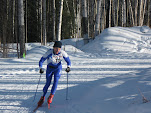Dressing Up for a Cold Run

Twenty five years later we have treadmills, myriad health club options, and for the hearty, high-tech gear. Assuming that you want to go outside for a cold run, here are suggestions for attire that will keep you warm and safe enough to complete a run when in sub-zero conditions.
Let’s start where it counts. You have to keep your core and key areas warm. For men wind briefs are almost mandatory. While women must bear the pain of childbirth, they have no idea what it’s like to have a frozen or thawing member. We don’t even want to think about frostbite. Polypropylene with a nylon shield. Wear it.
You can also wear vests that have a densely woven nylon windshield to protect your torso. My vest is made of Drytex, which wicks away moisture. It’s all good. While you won’t win any style awards with windbriefs and a vest, it would be enough to get you through a run in the low 30s (0 C).
Over the shorts I usually wear a thigh-length Speedo spandex swimsuit. This adds an extra layer for my thighs and hips. When it’s really cold, say less than -10 or -15 F (-26 to -29 C), I add polypropylene long underwear pants. And anytime it’s in the low single digits or below I’ll wear two layers of polypropylene shirts. Dressed with these you could go out and run comfortably at +15 F (-9 C).

To handle colder temperatures I wear Arctic Tights by Hind. These have a wool-polypro blend on the inside, and lycra on the outside. Along with the windbriefs and spandex swimsuit, these are good down to about zero. Below that your knees and quads get stiff and cold. The extra layer of polypro can fend off the cold, but it does feel a bit restrictive (nothing bulky like the snowsuits our mothers packed us into to play in the snow when we were kids—two steps and you fall into a snow drift hoping to be rescued by an attentive dad. You remember, “Dad? DAD? DAAAD? I can’t move…” With the tights and a nylon shell you could handle a run at about 0 F.
Sometimes instead of the long underwear I’ll put on standard nylon wind pants made for running. But if it’s really cold, like -20 F, or the run will be long, I go for the full monty, that is briefs, spandex swimsuit, polypro long underwear, tights, and nylon overpants.
Up top I typically wear add one more layer of core protection—a nylon vest that has a more or less fishnet back—underneath a double layered breathable jacket.
Now that we’ve covered the trunk and limbs, what about the extremities? Feet first. I now wear wool-polypro blend socks. My feet don’t get wet and they don’t get cold. One layer is fine. I don’t use expensive ice shoes, or push screws through the soles, but often will fit “shoe chains” that over the shoe to prevent any untimely slipping in front of a car, semi, or grizzly bear (actually the bears hibernate during winter). Ironically, when it gets very cold, say -10 or colder, traction gets better. Many things start to grind to a halt at extremely cold temperatures.
style="DISPLAY: block; MARGIN: 0px auto 10px; CURSOR: hand; TEXT-ALIGN: center" alt="" src="http://photos1.blogger.com/blogger/3880/1377/200/cold5.jpg" border="0" />

For my hands I wear “lobster claw” cross country ski mitts. These are well insulated, light, and breathable. And most importantly they don’t get soaked with sweat. If it’s extreme, I’ll put on a pair of polypro glove liners. Cold hands are not a problem with these.
Finally, I also layer my head. First I put on lightweight cross country ski ear muffs. Then, if it’s more than a few degrees below zero, a polypro balaclava, and then either wool or polyester running hat. Finally, I’m dressed and ready for a run.
Running in such cold conditions can still be tough. My eye’s frost up every few minutes and I have to take off a glove and wipe them clean. Probably clear-lens sports glasses would prevent that. As great as this gear is, the layers do slow you down, and your muscles just don’t work very well at sub zero. The slipping and sliding tends to make your joints ache a bit more. But if you’re dressed right, you can get through a long run safely.

For more on hard core running in the cold:
http://www.runningtimes.com/issues/03apr/fairbanks.htm This Running Times article, by Fairbanks runner Matias Saari, profiles the winter training adventures of five serious marathoners as they prepare for Boston.
http://www.runningclubnorth.org/lnk_cld1.htm Running Club North posts this piece on the challenges of winter running in the north country.
Photos by Mikko Sayre


0 Comments:
Post a Comment
Subscribe to Post Comments [Atom]
<< Home